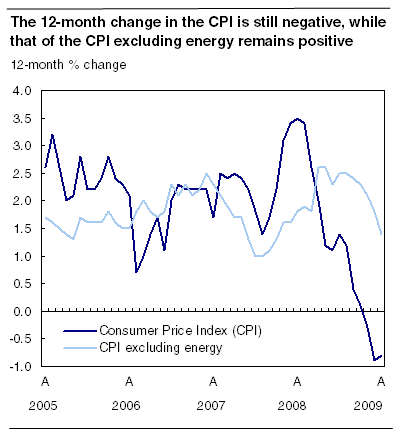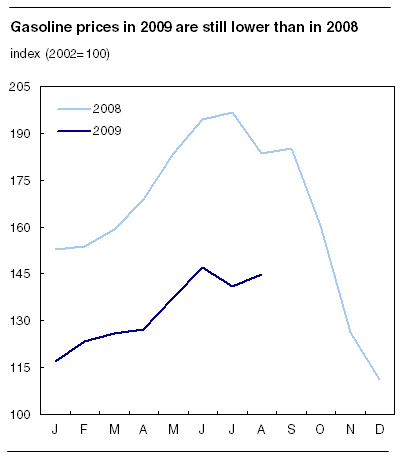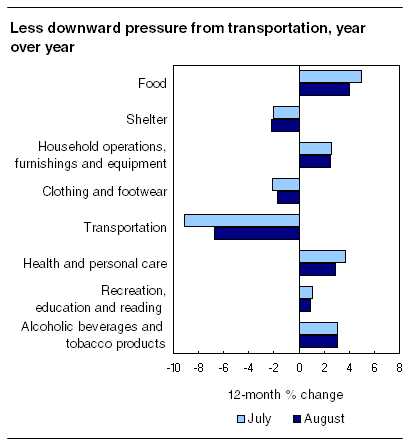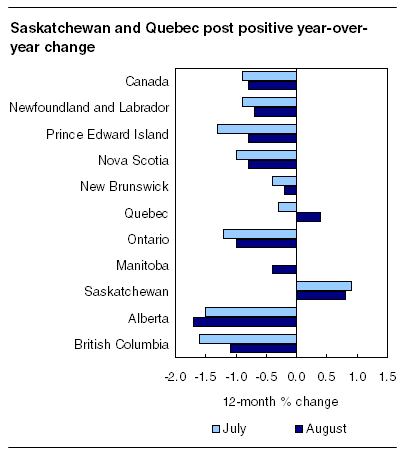Common menu bar links
Consumer Price Index
Archived Content
Information identified as archived is provided for reference, research or recordkeeping purposes. It is not subject to the Government of Canada Web Standards and has not been altered or updated since it was archived. Please "contact us" to request a format other than those available.
Consumer prices fell 0.8% in the 12 months to August 2009, following a 0.9% decline in July.
The decrease was due primarily to a 12-month drop of 19.1% in prices for energy products, mainly gasoline.
Excluding energy, the Consumer Price Index (CPI) rose 1.4% between August 2008 and August 2009.

Nationally, gasoline prices fell 21.2% between August 2008 and August 2009, following a 12-month decline of 28.3% in July. Regular unleaded gasoline prices at self-service stations averaged $1.01 per litre in August compared with $1.27 per litre in August 2008.
Of the eight major components in the CPI, three recorded declines in the 12 months to August: transportation, shelter, and clothing and footwear. The most significant downward contributor was transportation, which reflected lower prices for gasoline, as well as passenger vehicles, and air transportation.
In the shelter component, prices for natural gas, fuel oil and other fuels, and homeowner's replacement costs were lower than in August 2008, continuing their downward trend.

The primary upward pressure on the CPI came from food prices, which increased 4.0% between August 2008 and August 2009. Household operations, furnishings and equipment (+2.5%) and health and personal care (+2.9%) also contributed to the increase.
Seasonally adjusted monthly CPI increases
On a seasonally adjusted monthly basis, the CPI rose 0.3% from July to August, after declining 0.3% from June to July. August's increase was due primarily to a 0.4% rise in the transportation cost index. A monthly increase in prices for gasoline in August compared with July largely accounted for the rise. The seasonally adjusted monthly CPI has gone up in three of the past four months.
12-month change: Continuing declines in transportation, shelter, and clothing and footwear costs
Lower prices for gasoline, passenger vehicles, and air transportation drove down transportation costs by 6.7%, making it the most significant downward contributor to the CPI in the 12 months to August.
In addition to the decline in gasoline prices (-21.2%), prices for purchasing passenger vehicles fell 4.7% in August, following a 4.3% decrease in July. However, a 4.8% increase in passenger vehicle insurance premiums mitigated the overall drop in the transportation component.
Downward movements in the shelter index continued to gain momentum, as prices decreased 2.2% in the 12 months to August, following declines of 2.0% in July and 0.8% in June. The decline in August was primarily the result of persistent price decreases in natural gas, fuel oil and other fuels since energy prices peaked in the summer of 2008. Shelter costs were also dampened by declines in homeowner's replacement costs and in mortgage interest costs.
The mortgage interest cost index, which measures the change in the interest portion of payments on outstanding mortgage debt, fell 1.1% in August, following a 0.1% decrease in July.

Clothing and footwear prices fell 1.7% between August 2008 and August 2009, led by lower prices for both women's and men's clothing.
Food costs put significant upward pressure on overall prices, albeit to a lesser degree than in previous months. In the 12 months to August, food prices rose 4.0%, compared with increases of 5.0% in July and 5.5% in June. Upward price movements for meat, fresh fruit, and fresh vegetables have eased from record highs in recent months.
A major contributor to higher food prices in the 12 months to August was food purchased from restaurants, which rose 3.1%. As well, price increases of 5.7% for fresh vegetables and 10.1% for sugar and confectionery were partly responsible for the overall rise in food prices.
Price increases were widespread within household operations, furnishings and equipment. Upward pressure came from the cost of child care (+4.1%), financial services (+7.8%) and pet food (+10.3%).
As well, broadly-based price advances were observed in the health and personal care component, which includes personal care services (+3.2%) and prescribed medicines (+3.7%).
Provinces: Consumer prices down in eight provinces
Consumer prices declined in eight provinces between August 2008 and August 2009.

Consumer prices declined at the fastest pace in Alberta (-1.7%) and British Columbia (-1.1%).
In Alberta, prices were down for the fifth consecutive month. The main factor in the decline was a 6.1% decrease in shelter costs in the 12 months to August, a much larger drop than the 2.2% national decline. This was due mainly to a 28.6% drop in energy costs and a 10.0% decline in homeowner's replacement costs.
In British Columbia, the two main factors in the decline over the 12 months to August were an 18.0% decrease in energy costs and a 14.9% decline in homeowner's replacement costs.
Saskatchewan and Quebec were the only two provinces to experience price increases.
In Saskatchewan, consumer prices rose 0.8% in the 12 months to August after increasing 0.9% in July. This was due to higher costs for food (+4.9%) and shelter (+2.9%).
In Quebec, consumer prices rose 0.4% in the 12 months to August. This was due to a slower decline in shelter costs (-0.3%) compared with the national decline (-2.2%).
Consumer prices were down 1.0% in Ontario. Energy prices in this province fell 20.0% between August 2008 and August 2009.
12-month change in the Bank of Canada's core index
The Bank of Canada's core index advanced 1.6% over the 12 months to August, following a 1.8% rise in July.
The seasonally adjusted monthly core index edged up 0.1% from July to August, following no growth from June to July.
For a more detailed analysis, consult the publication The Consumer Price Index.
Available on CANSIM: tables 326-0009, 326-0012, 326-0015 and 326-0020 to 326-0022.
Definitions, data sources and methods: survey number 2301.
More information about the concepts and use of the CPI are also available in Your Guide to the Consumer Price Index (62-557-X, free) from the Publications module of our website.
The August 2009 issue of The Consumer Price Index, Vol. 88, no. 8 (62-001-X, free), is now available from the Publications module of our website. A paper copy (62-001-X, $12/$111) is also available. A more detailed analysis of the CPI is available in this publication. See How to order products.
The September Consumer Price Index will be released on October 16.
For more information, or to enquire about the concepts, methods or data quality of this release, contact the Dissemination Unit (toll-free 1-866-230-2248; 613-951-9606; fax: 613-951-2848; prices-prix@statcan.gc.ca), Consumer Prices Division.
Table 1
| Relative importance2 | August 2008 | August 2009 | July 2008 to July 2009 | August 2008 to August 2009 | |
|---|---|---|---|---|---|
| Unadjusted | |||||
| % change | |||||
| All-items | 100.003 | 115.6 | 114.7 | -0.9 | -0.8 |
| Food | 17.04 | 116.8 | 121.5 | 5.0 | 4.0 |
| Shelter | 26.62 | 123.8 | 121.1 | -2.0 | -2.2 |
| Household operations, furnishings and equipment | 11.10 | 104.4 | 107.0 | 2.6 | 2.5 |
| Clothing and footwear | 5.36 | 93.7 | 92.1 | -2.1 | -1.7 |
| Transportation | 19.88 | 123.1 | 114.8 | -9.1 | -6.7 |
| Health and personal care | 4.73 | 109.3 | 112.5 | 3.7 | 2.9 |
| Recreation, education and reading | 12.20 | 103.5 | 104.4 | 1.1 | 0.9 |
| Alcoholic beverages and tobacco products | 3.07 | 127.5 | 131.4 | 3.1 | 3.1 |
| All-items (1992=100) | 137.6 | 136.6 | -0.9 | -0.7 | |
| Special aggregates | |||||
| Goods | 48.78 | 111.5 | 107.8 | -3.9 | -3.3 |
| Services | 51.22 | 119.6 | 121.6 | 1.8 | 1.7 |
| All-items excluding food and energy | 73.57 | 110.5 | 111.5 | 1.0 | 0.9 |
| Energy | 9.38 | 164.0 | 132.6 | -23.4 | -19.1 |
| Core CPI4 | 82.71 | 112.0 | 113.8 | 1.8 | 1.6 |
Table 2
| Relative importance1 | August 2008 | August 2009 | July 2008 to July 2009 | August 2008 to August 2009 | |
|---|---|---|---|---|---|
| Unadjusted | |||||
| % change | |||||
| Canada | 100.002 | 115.6 | 114.7 | -0.9 | -0.8 |
| Newfoundland and Labrador | 1.27 | 115.8 | 115.0 | -0.9 | -0.7 |
| Prince Edward Island | 0.35 | 119.3 | 118.3 | -1.3 | -0.8 |
| Nova Scotia | 2.56 | 117.7 | 116.7 | -1.0 | -0.8 |
| New Brunswick | 1.97 | 114.3 | 114.1 | -0.4 | -0.2 |
| Quebec | 21.05 | 113.5 | 113.9 | -0.3 | 0.4 |
| Ontario | 41.22 | 114.8 | 113.7 | -1.2 | -1.0 |
| Manitoba | 3.06 | 115.0 | 114.5 | 0.0 | -0.4 |
| Saskatchewan | 2.64 | 117.0 | 117.9 | 0.9 | 0.8 |
| Alberta | 11.43 | 124.1 | 122.0 | -1.5 | -1.7 |
| British Columbia | 14.29 | 114.0 | 112.8 | -1.6 | -1.1 |
| Whitehorse | 0.06 | 115.4 | 114.2 | -0.8 | -1.0 |
| Yellowknife | 0.08 | 116.9 | 116.3 | -0.1 | -0.5 |
| Iqaluit (Dec. 2002=100) | 0.02 | 112.2 | 114.0 | 1.5 | 1.6 |
Table 3
| Relative importance1 | June 2009 | July 2009 | August 2009 | June to July 2009 | July to August 2009 | |
|---|---|---|---|---|---|---|
| Seasonally adjusted | ||||||
| % change | ||||||
| All-items | 100.002 | 114.4 | 114.0 | 114.3 | -0.3 | 0.3 |
| Food | 17.04 | 121.6 | 121.8 | 121.7 | 0.2 | -0.1 |
| Shelter | 26.62 | 121.3 | 120.9 | 121.1 | -0.3 | 0.2 |
| Household operations, furnishings and equipment | 11.10 | 107.3 | 107.2 | 107.3 | -0.1 | 0.1 |
| Clothing and footwear | 5.36 | 93.0 | 92.6 | 92.4 | -0.4 | -0.2 |
| Transportation | 19.88 | 116.1 | 114.3 | 114.8 | -1.6 | 0.4 |
| Health and personal care | 4.73 | 112.4 | 112.4 | 112.5 | 0.0 | 0.1 |
| Recreation, education and reading | 12.20 | 103.1 | 103.1 | 103.1 | 0.0 | 0.0 |
| Alcoholic beverages and tobacco products | 3.07 | 131.6 | 131.5 | 131.4 | -0.1 | -0.1 |
| Special aggregates | ||||||
| All-items excluding food | 82.96 | 113.6 | 113.1 | 113.4 | -0.4 | 0.3 |
| All-items excluding food and energy | 73.57 | 111.5 | 111.5 | 111.5 | 0.0 | 0.0 |
| All-items excluding eight of the most volatile components | 82.71 | 112.3 | 112.3 | 112.5 | 0.0 | 0.2 |
| Core CPI3 | 82.71 | 113.7 | 113.7 | 113.8 | 0.0 | 0.1 |

